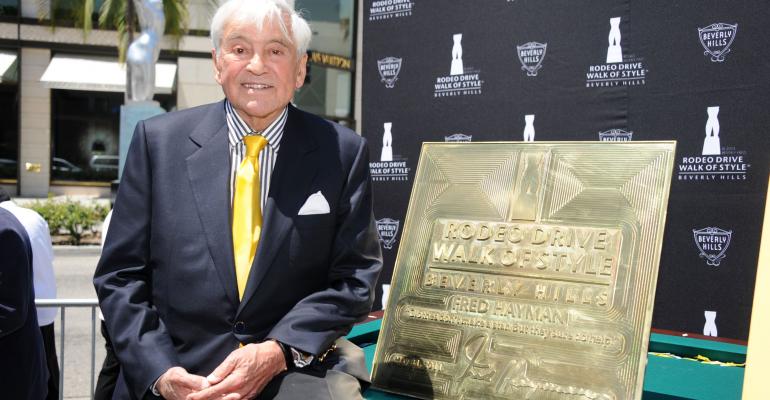Fred Hayman built his fortune in glamorous Beverly Hills, Calif. For decades, he owned the chic Giorgio Beverly Hills boutique on Rodeo Drive and its subsequent incarnation, Fred Hayman Beverly Hills. Dubbed the “godfather of Rodeo Drive,” he also went on to launch, and then sell, the Giorgio fragrance line.
Hayman died in 2016 at age 90, but his entrepreneurial spirit lives on.
Today, Fred Hayman’s son Robert serves as CEO of Los Angeles-based Hayman Properties LLC, which invests in commercial real estate. In 2017, Hayman Properties set up a new division, Hayman Family Office, to grow its real estate portfolio by attracting other family offices as co-investors. Real estate veteran DJ Van Keuren leads Hayman Family Office as vice president.
Van Keuren, author of “The Family Office Guide to Real Estate and Commercial Investment” and founder of USFamilyOfficeRealEstate.com, landed at Hayman Properties after overseeing real estate investments for a single-family office in Colorado, where he still lives.
Shifting away from Hayman Properties’ holdings in multifamily, retail and class-A office, Hayman Family Office is now targeting acquisitions of class-B office buildings in secondary markets—such as Austin, Texas; Denver and Salt Lake City—that boast a reasonable cost of living, a high quality of life and robust job growth. The current 17-asset Hayman portfolio comprises mostly office buildings. The portfolio’s total value is around $800 million, according to Van Keuren.
In a Q&A with NREI, Van Keuren dives into Hayman Family Office’s class-B office strategy, its plan to entice other family offices to be co-investors and the outlook for real estate investments by family offices in general.
The Q&A has been edited for length, style and clarity.
NREI: Why is Hayman Family Office concentrating on class-B office properties?
DJ Van Keuren: The reason why is there [are] about 10 billion sq. ft. of office space in the United States. Of that, 5 billion is class-B. That seems to be the biggest area of opportunity on the office side. With class-B, you can do the value-add play and get that lift by repositioning the assets. You’re able to buy at some decent cap rates, depending on the markets.
NREI: What does Hayman Family Office plan to do with its portfolio of class-B properties?
DJ Van Keuren: We’re focused on creating a difference with what our buildings look like and feel like compared with other class-B offices.
NREI: What does your class-B acquisition strategy look like?
DJ Van Keuren: Our plans are to go out in 2018 and buy 10 to 12 properties. The following year, we’ll ramp that up to probably 15 to 18. We’re looking for between $10 million and $40 million in asset size and roughly 80,000 sq. ft.—properties underneath the REITs and institutions, but bigger than “country club money.” We’re ideally looking for assets where there’s cash flow coming out of the gate that is going to shoot off 7 to 8 percent yield, and then we’re able to get between 15 and 20 percent IRRs over a three- to five-year period.
NREI: What is keeping you away from class-A office assets?
DJ Van Keuren: You usually have the institutions looking at the class-A properties. The sweet spot is underneath that radar and above the “country club money.” Also, with the class-B properties, you get better yields in general. You’ve usually got a little bit more work to do because the class-B asset is older, but it provides greater upside.
NREI: How much competition do you expect to face from institutional investors?
DJ Van Keuren: I think what you’re going to see happening is the institutions are going to start moving more and more into secondary markets, and they’re going to start creeping lower in order to get that yield. They’re not going to have a choice; they’re going to have to do that. Ultimately, it’s going to drive competition, which means it’s good for the sellers and bad for the buyers; those cap rates are going to start getting compressed as the institutional capital starts coming into the market.
NREI: What are your hopes for recruiting other family offices as co-investors?
DJ Van Keuren: My target is to get about 12 to 15 families that want to co-invest with us on a longer-term basis and piggyback off our platform and the expertise we have in this specific area.
NREI: Will you go outside the U.S. to find family offices to team up with?
DJ Van Keuren: From my perspective, there’s enough families in the U.S. that there’s no reason for me to go overseas. If I can’t find 15 families in the U.S. that want to invest with us on opportunities, then I guess I’d go overseas, but I find that hard to believe.
NREI: What does 2018 hold for real estate investments by family offices?
DJ Van Keuren: On a global basis, family offices have anywhere between 15 and 18 percent of their portfolios in real estate. What’s happened over the last couple of years is you had a lot of families that were doing direct deals, so they’d invest in the property themselves or, most likely, with an experienced operator and had sort of gotten away from the private equity funds. However, the majority of investments for families are still through a private equity fund of some sort. In 2017, what started to happen—which I think will go into 2018—is families started to look for yield. So many families have started to take a look at cash-flowing real estate as a bond alternative.

